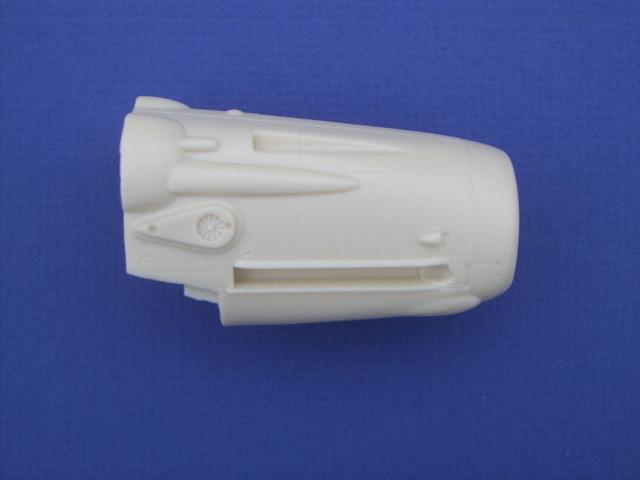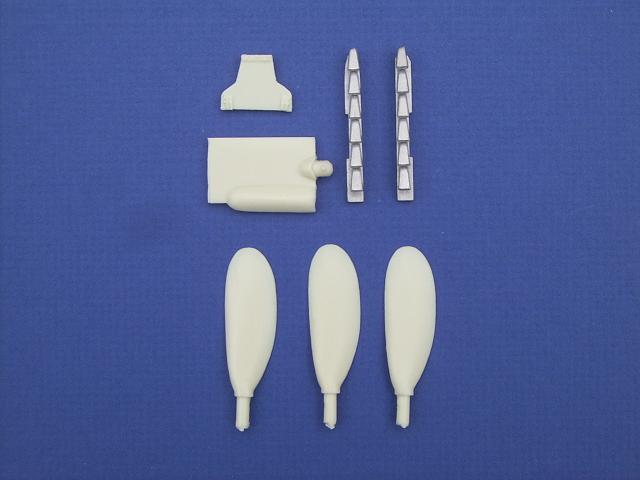ARBA | 1/32 Avia S-199 Conversion Set
Reviewed by Steve Messer

Better known for their smaller scale resin WW2 Luftwaffe subjects, English aftermarket supplier ARBA has aimed for something a little different for their first effort in 1/32nd scale, a conversion set for the Hasegawa G-14 kit - The AVIA S-199. This Czech-built version of the Bf 109G14 went into post war production with Jumo 211F engines after the stocks of DB605s were destroyed by fire, but this heavier engine, with opposite rotation, greater torque and driven by large paddle prop blades, converted the Messerschmitt's basic design faults into sheer murder. Dubbed "Mezec" (Mule) by the Czechs, the S-199 served there for a decade, but it's perhaps in Israeli service that the type is best remembered, providing the only aerial defence of the fledgling nation in 1948 until better, more reliable types could be sourced.


The ARBA set comes in their trademark white box; the contents including 11 resin parts, 2 white metal exhaust stacks, decal sheet and colour instruction sheet. The major part is a completely new power egg, moulded in solid resin with starboard compressor intake, elongated fairings for the Jumo's different engine bearers, rounded cowl front towards the spinner, and a separate underside panel where the oil cooler would normally sit. Some trimming of the rear end will be required, and there is a slight "orange peel" texture to the resin but not too bad that a slight sanding won't remove. This is a large, heavy part, and the modeller may wish to construct longitudinal supports and fuselage spreaders to ensure a correct fit that will keep it in place despite its weight. The detail is good on the whole, however some negative points rate a mention: the underside bulges to cover the Jumo's camshafts are moulded asymmetrically, the port side is in the correct position, but the starboard is a little low and the purist may wish to modify it to a position level with the port bulge. The small bumps protruding from the large cannon bulges should be removed, these are only applicable for Czech machines. Also, the hole for the mounting the spinner shaft is offset to the starboard (see photo).


Other resin parts include G10-type wheel well bulges, slightly weighted wheels with smooth treads, one-piece spinner with larger paddle prop blades, canopy mounted armour plate and slightly hollowed white metal exhaust stacks. These parts generally have good detail, the wheels and tyres seem to be based on the Hasegawa originals, and the new spinner and blades appearing dimensionally accurate.

The decals provided are by UK supplier Fantasy Printshop, and are printed with very good alignment and registration. The colours and especially the white areas appear quite dense, although I've not applied these yet they should go on well if Fantasy's examples supplied to MDC are anything to go by. There are no instructions as such, there is a "Decal placement" guide supplied, which appears to be a xerox copy of a xerox copy... some of the details are hard to pick out due to it's re-copied appearance. The markings provided are for either of two Israeli aircraft from the 1948 War of Independence : D-114 flown by 101 Squadron CO Mody Alon (who was killed in this aircraft Oct.16 1948) and D-121 flown by Ezer Weizman during the same sortie, having also been the aircraft used by Rudy Augarten to shoot down an Egyptian spitfire earlier the same day. The guide gives the overall colour as RLM 02, which seems to be the accepted rule, although there is speculation it may be a lighter, semigloss paint of a similar hue. Also, D-114 is shown with red spinner but not the red/white striped rudder, which is an unusual combination, but it's hard to be sure without photographic evidence to counter this proposition.
To sum up, I have some mixed feelings about this kit. The quality and detail of the resin parts is very good, as are the decals provided. The experienced modeller can I'm sure can wing it sufficiently without instructions, but I was disappointed by the quality of colour guide provided, and it's lack of specifics - the wheel wells are shown totally blank white, there's no reference to cockpit colours, etc. Aircraft D-121 is depicted with chin mounted oil cooler ala' standard Bf 109, and while some Israeli S-199's were retrofitted with chin intakes, they were different in style and shape to the Hasegawa kit part, which the unwary may be tempted to use. Couple these points with the fact you're not provided with any photo-etch or cockpit parts, and I felt that for a conversion set worth the price of the donor kit, I was wanting just a little more. Recommended, if only for the bits you do get.
Review Sample Compliments of ARBA Resins from England.
© Steve Messer 2006
This review was published on Saturday, July 02 2011; Last modified on Wednesday, May 18 2016
